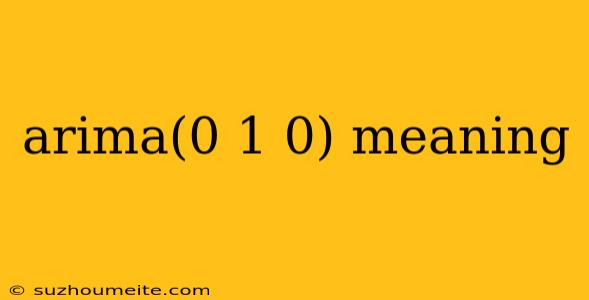ARIMA(0, 1, 0) Meaning
ARIMA stands for Autoregressive Integrated Moving Average, and it's a statistical method used for forecasting time series data. The numbers in the parentheses (p, d, q) represent the order of the model.
ARIMA(0, 1, 0), also known as a random walk model, is a specific type of ARIMA model with the following parameters:
- p = 0: Indicates that there is no autoregressive component. This means the model does not consider past values of the time series to predict future values.
- d = 1: Indicates that the time series is integrated of order one. This means that the time series is differenced once to make it stationary. Stationarity means that the statistical properties of the time series (like mean and variance) remain constant over time.
- q = 0: Indicates that there is no moving average component. This means the model does not consider past forecast errors to predict future values.
In simpler terms, an ARIMA(0, 1, 0) model assumes that the future value of the time series is simply equal to the previous value plus a random error term.
Here's a breakdown of what the model does:
- Differencing: The model first takes the difference between consecutive values in the time series. This helps to remove the trend and make the data stationary.
- Random Walk: The model then assumes that the differenced series follows a random walk process. This means that the next value in the series is equal to the previous value plus a random noise component.
- Forecasting: To forecast future values, the model simply projects the current value forward with the addition of a random noise term.
When to use ARIMA(0, 1, 0):
- When the time series data shows a clear trend but no clear seasonality.
- When the differenced data appears to be random with no significant autocorrelation.
Limitations of ARIMA(0, 1, 0):
- It assumes that the time series follows a simple random walk process, which may not always be the case in real-world data.
- It cannot capture seasonality or other complex patterns in the data.
Example:
Imagine you're tracking the daily stock price of a company. If the stock price follows a random walk pattern, then an ARIMA(0, 1, 0) model could be used to forecast future prices. The model would assume that the next day's price is simply equal to the current price plus a random noise term.
Important Note: This is a simplified explanation of ARIMA(0, 1, 0). In practice, there are many other considerations and aspects to this model. It's recommended to consult with a statistician or data scientist for a more in-depth understanding and application.
